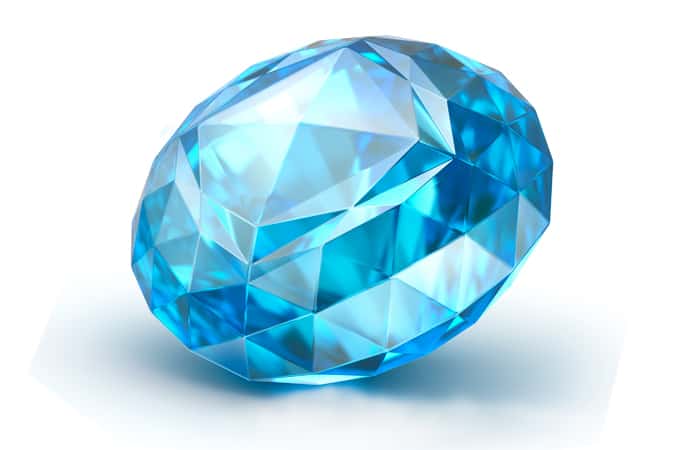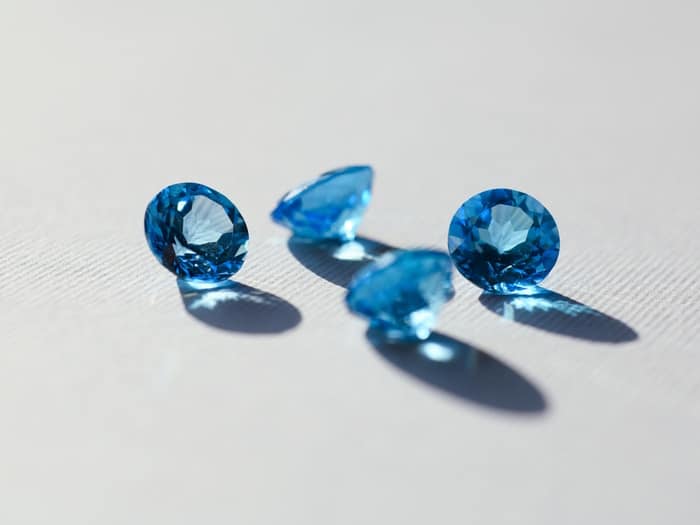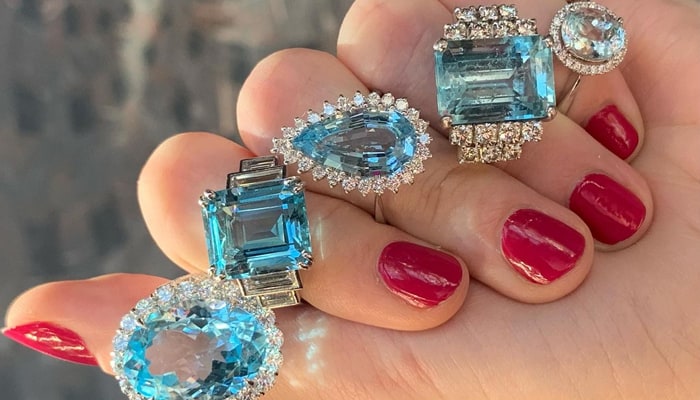Aquamarine belongs to the beryl family of gemstones with a similar chemical composition to the rest of the family members including yellow beryl, morganite, emerald, and others. What makes aquamarine distinct is the dark blue to light blue colors that feature some touch of green.

Types of Aquamarine
There are synthetic and natural types of aquamarines. Natural aquamarine varieties have a pale color, while synthetic stones have a deep blue color with impurities. The synthetic versions are produced in controlled settings with the use of a hydrothermal process with the same physical and chemical properties as their natural counterparts. However, synthetic aquamarines are a cheaper option if you have always wanted to own these blue beauties with no need to invest a lot of money.
Similar to other gemstones, carat, color, clarity, and cut determine the value of aquamarine stones, making them the four factors to consider when shopping for these blue beauties.
Factors to Consider When Buying Aquamarine
There is a good reason why aquamarine is among the most renowned semi-precious stones out there. Aquamarines are available in a wide selection of sizes, though, not to mention that this gemstone is quite abundant.
You can pick the size of the gemstone depending on your personal preference. However, you will notice that it is rare for jewelry pieces to feature small aquamarine stones because these don’t feature a vibrant hue.
The cut of aquamarine determines how much the stone sparkles as well as its shape. This means that a well-cut aquamarine has good sparkle. Aquamarines are well-loved among professional gem cutters since it is possible to cut rough aquamarine into different shapes.
Since aquamarines are mostly available in bigger sizes, there is no significant increase in the large gems’ price per carat. Cut aquamarines more than 25 carats are priced lower per carat compared to similar quality smaller stones. Wearing and setting stones of this size is tricky, which explains their low demand.
The prices of aquamarine are dependent on the purity and depth of clarity and color. Smaller aquamarines of good quality and less than 5 carats range from $100 up to $250 per carat. Meanwhile, large aquamarines are priced from approximately $300 up to $600 per carat.

Colors
When shopping for aquamarines, the stone’s color should always be your first consideration because this is the most crucial factor here. The stone is more valuable if its color is deeper.
The colors of aquamarine stones range from strong sea blue to pale blue color, with the deep colors being the most valuable. Deeply saturated blue is the most valued and desired aquamarine shade.
The most important criterion that you also need to pay closer attention to is the color’s intensity. While there are buyers who want their aquamarine gems to feature a light green shimmer, the most valuable aquamarine stones have a pure and almost clear blue appearance.
Smaller-sized aquamarine stones often have a lighter hue since their size can affect their ability to boast a deep blue color. Remember this if you have plans to use aquamarines as adjacent stones that will complement a bigger stone at the center.
Clarity
Many aquamarine gemstones are clean without any noticeable imperfections or inclusions. Be sure to check the stone and confirm that it is eye-clean before you buy it. This way, you can have peace of mind knowing that the stone you will get has excellent clarity and transparency.
The highest quality of aquamarine must be clean with excellent clarity and transparency, showcasing an exceptional shine. The majority of faceted aquamarine stones are eye-clean. While certain crystals may feature some liquid inclusions, clarity characteristics are absent or few in many finished gems. Aquamarine stones with inclusions visible to the eye are often fashioned into carvings, beads, or cabochons.
There are also sufficient parallel inclusions in some aquamarines, typically liquid-filled or long hollow tubes, to let cutters fashion the rough to showcase a cat’s eye.
But considering the relative abundance and classification of aquamarines, there is very little reason for you to buy one with noticeable inclusions.
Cut
Aquamarine stones can be cut into almost all shapes although cutters usually fashion these as oval or round brilliants or as emerald cuts. Most gem artists also use aquamarines for exceptional designer cuts since their styles can maximize the high clarity and pure and even color of the material.
Since there are fairly plentiful rough aquamarines, it is quite common to find well-cut stones. The transparency and hardness of the gemstone make it in demand among carvers, artists, and designers. Gem sculptors also use aquamarine for ornamental objects and fantasy cuts.
Being pleochroic means that aquamarine shows various colors in various crystal directions that are strong blue and near-colorless. The blue pleochroic color is in line with the cutting orientation that can retain most of the weight in which the table facet has a parallel alignment to the crystal’s length.

Carat Weight
You can find aquamarine in large sizes and most fine gems of 25 carats or higher are widely available. Smaller accent sizes in general are pale. It is more likely for cut gems to have a darker hue if they are bigger than 5 carats.
Aquamarines come in sizes ranging from very large to very small, with the biggest ones weighing up to 45 kilograms or 100 pounds. While big stones are readily available, using them in jewelry pieces can be tricky, so they have lower demand, with center stones being the only exception. This is why the prices per carat tend to go lower for sizes of more than 25 carats.
Numerous aquamarine crystals of very large size have already been discovered. It was in Minas Gerais, Brazil when the biggest recorded Brazilian aquamarine was discovered in 1910 weighing 110 kg or 244 lbs. with a diameter of 38 cm or 15 in. and length of 48 cm or 19 in.
Setting
Aquamarine looks most stunning in rings. But since it is less durable than sapphires or diamonds, aquamarines must have a robust setting of platinum or gold to keep them protected from scratches and knocks as a result of daily wear and tear.
Conclusion
When buying aquamarine, always check the color and color intensity. Pick a darker color if you are looking for the most valuable piece. Choose a stone with eye-clean clarity, a well-proportioned cut, and overall brilliance.



